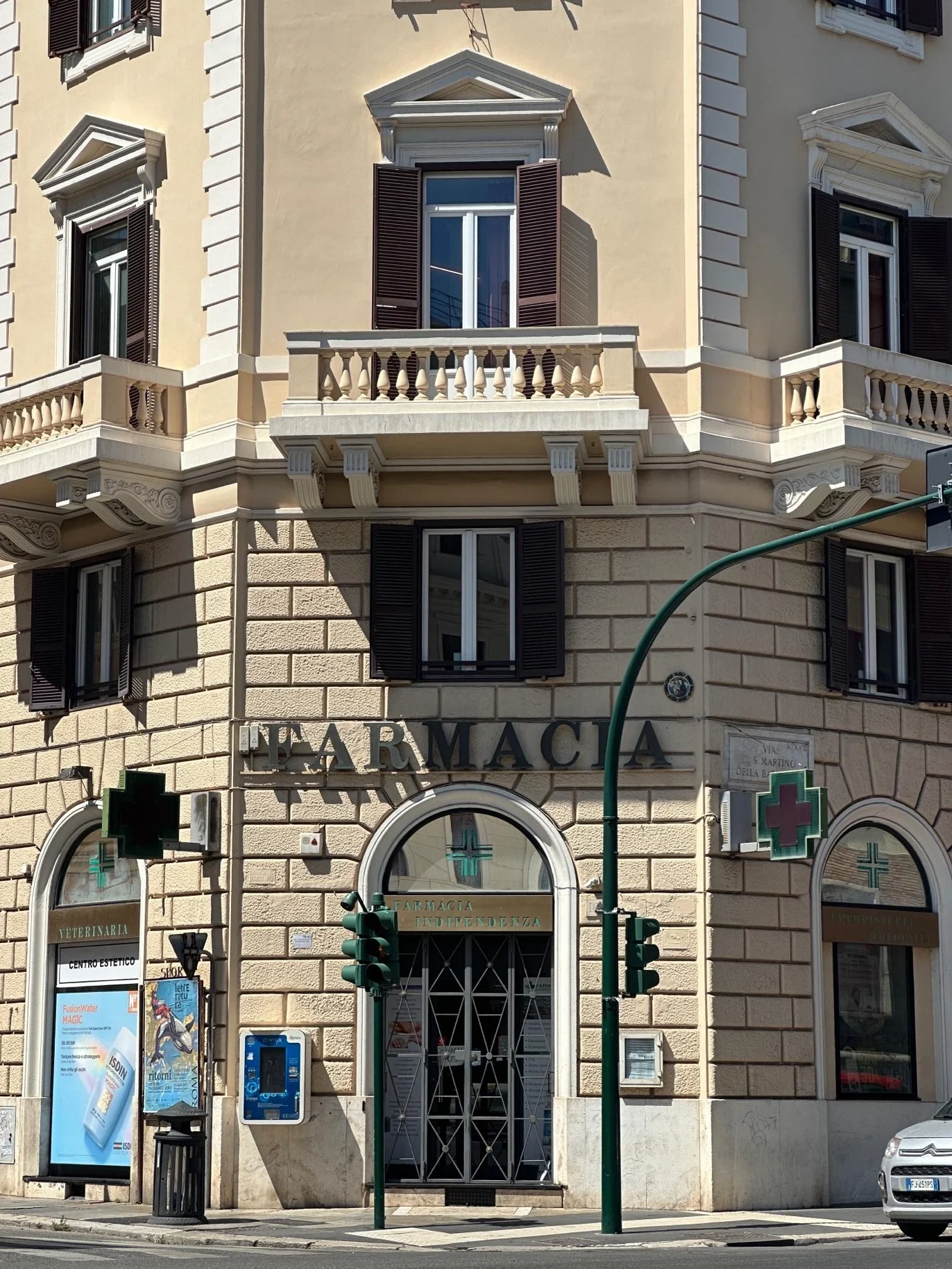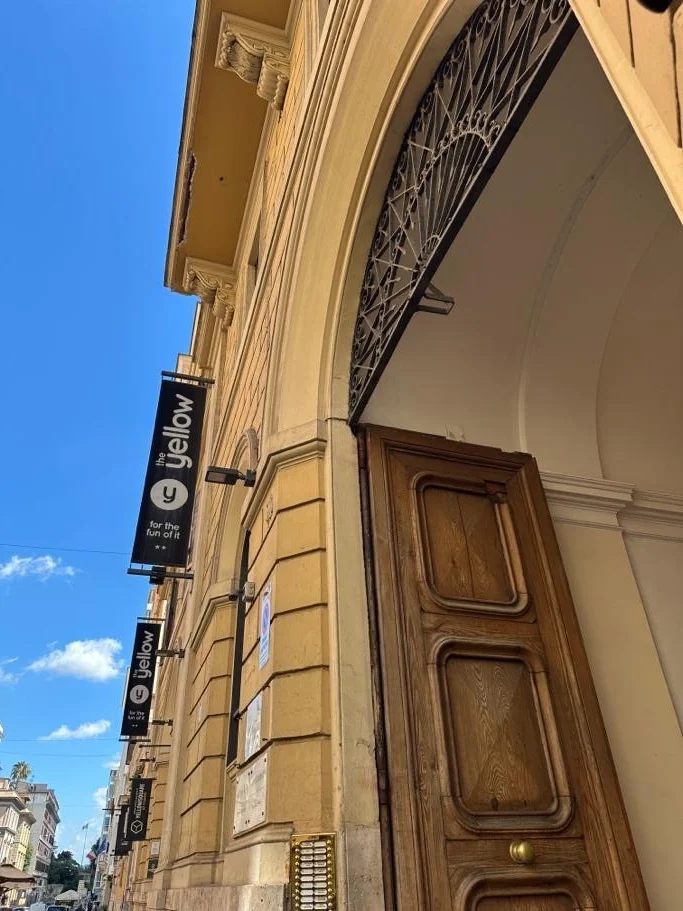Italy, Travel
Surviving the Italian Pharmacy: A Traveller’s Guide to Feeling Better Abroad
Ever gotten sick while traveling? Here’s how to navigate Italian pharmacies like a pro.
We’ve all been there: you wake up in a foreign country with a scratchy throat, a pounding headache, or a stomach that regrets last night’s fourth helping of carbonara. Suddenly, your sunny Roman holiday turns into a hunt for medicine — and you quickly realize there’s no Walgreens, no Boots, and certainly no 24-hour Walmart nearby.
But don’t panic! Italian pharmacies are easy to find, and with this handy guide, you’ll know exactly what to say, where to go, and what to ask for when you’re feeling under the weather in Italy.

How to Spot a Pharmacy in Italy
Look for a green, glowing cross sign — this is the universal symbol for pharmacies in Italy. Most pharmacies (called a “farmacia” in Italian) are independently owned, and you’ll usually find at least a few in every neighbourhood.
In Rome, for example, there are over 10 pharmacies within a 10-minute walk of the YellowSquare, so you’ll never be far from help.
Pharmacies typically open from 8:30 AM to 1:00 PM and 3:30 PM to 7:30 PM, Monday through Saturday, with reduced hours on Sundays. If you’re unwell outside these hours, don’t worry — you can check which pharmacies are open later or on holidays via the Farmacie di Turno Roma website. It’s a useful tool for finding pharmacies currently open in your area, especially on Sundays and evenings.


Cultural Curiosities:
Pharmacies Work Differently Here
In Italy, pharmacies aren’t mini-supermarkets like you might find in many English-speaking countries. While you’ll often find personal care items like shampoo, skincare, cosmetics, herbal remedies, and baby products, you won’t see shelves of snack foods, cold drinks, or everyday groceries next to your aspirin. Pharmacies here are primarily health and wellness hubs, and many over-the-counter medicines available elsewhere require a pharmacist’s approval.
Italian pharmacists act more like community health advisors — you describe your symptoms, and they’ll suggest the appropriate medication. This makes it incredibly helpful for travellers because even if you don’t know the name of the medicine you need, you can explain how you feel and they’ll find a solution.
Common Ailments & Their Italian Names
To make things easier, here’s a cheat sheet of common travel illnesses and their Italian translations:
- Flu = febbre
- Cold = raffreddore
- Allergies = allergie
- Cough = tosse
- Stuffy nose = naso chiuso
- Runny nose = naso che cola
- Sore throat = mal di gola
- Headache = mal di testa
- Migraine = emicrania
- Upset stomach = mal di stomaco
- Food poisoning = intossicazione alimentare
- Bug bites = punture di insetti
What to Say at the Pharmacy
If you want to be extra prepared, you can use this simple phrase:
“Buongiorno! Ho un [symptom] e cerco una medicina, per favore.”
(Hello! I have a [symptom] and I’m looking for medicine, please.)
Example: “Buongiorno! Ho un raffreddore e cerco una medicina, per favore.”
Most Popular Over-the-Counter Medicines
These are a few names you’re likely to hear:
- Tachipirina: Paracetamol-based, for fever and minor pain.
- Oki: Anti-inflammatory for sore throats, headaches, or joint pain.
- Moment: Ibuprofen for headaches, cramps, or fever.
- Enterogermina: Probiotic for stomach issues or after food poisoning.
- Imodium: Same brand as elsewhere, for diarrhoea.
- Vicks Tosse: Cough syrup.
- Zerinol: Cold and flu tablets.
Note: Antibiotics always require a doctor’s prescription in Italy.
Pharmacy Culture Tips: What Else You Should Know
Italian pharmacies have a few quirks that can surprise travellers:
- Most over-the-counter medicines are kept behind the counter. You’ll rarely see boxes of cold medicine on open shelves. Describe your symptoms and the pharmacist will retrieve what you need.
- Pharmacists are highly trained healthcare professionals in Italy. Think of them more like clinical advisors than cashiers. Don’t hesitate to ask for advice or recommendations.
Note: For prescription-only or controlled medications, you may occasionally be asked for ID or a prescription from a local doctor; but for standard pharmacy purchases, it isn’t required.
What NOT To Do
- Don’t take medications without knowing exactly what they are and what they’re for. Even if a fellow traveller swears by something, check with a pharmacist first — some drugs available elsewhere might not be recommended or necessary for your symptoms.
- Always double-check ingredients on unfamiliar medicine. Products might have the same active ingredients as what you’re used to under a different name, or be completely different but used for the same thing. Ask the pharmacist to explain it if you’re unsure.
- Consider seeing a doctor if your symptoms persist more than a few days or get worse. You can book English-speaking doctors online via services like Doctors in Italy.
Final Thoughts
Getting sick abroad can be stressful, but it doesn’t have to ruin your trip. With this guide, you’ll be ready to face the Italian pharmacy system confidently, whether you need a quick fix for a hangover headache or something more serious.
Stay safe, travel smart, and remember to pack a basic travel medicine kit before you go!
Links
- Farmacie di Turno Roma list: https://www.farmaciediturno.org/comune.asp?cod=58091
- Google Maps results for pharmacies near YS Rome: https://maps.app.goo.gl/JYaHNTBKgx2EZLUB7
- YS Rome’s closest pharmacy: https://maps.app.goo.gl/8hDhFKSAssMnBjU98
Service for finding English-speaking doctors: https://www.doctorsinitaly.com/
